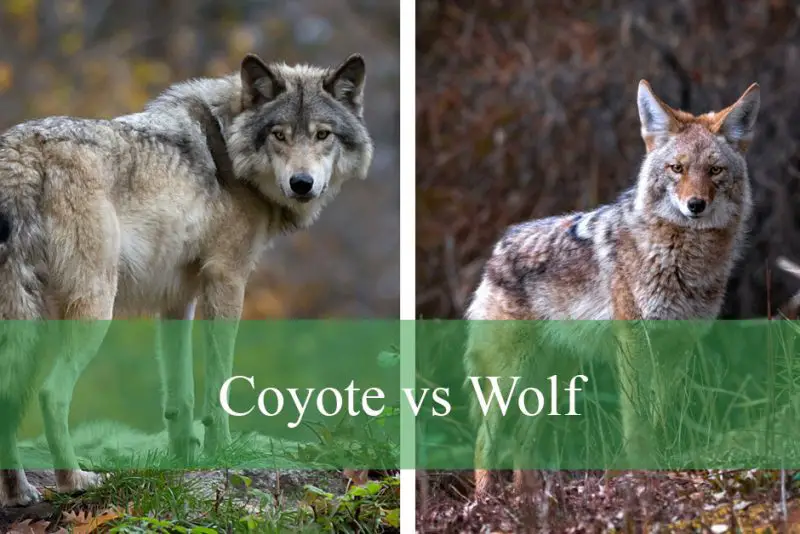When it comes to wild canids in North America, two animals often spark curiosity and confusion alike: the coyote and the wolf. Both belong to the same family, Canidae, and share many similarities in appearance and behavior. However, these two species are distinct in numerous ways, ranging from physical traits and social behavior to ecological roles and habitats. Understanding these differences not only helps wildlife enthusiasts and nature lovers identify them correctly but also deepens our appreciation for their unique roles in the ecosystem.
In this article, we will explore the key differences between coyotes and wolves in detail. From their size and physical features to their social structure and vocalizations, every aspect will be examined closely. If you’ve ever wondered how to tell a coyote from a wolf or what sets them apart, this comprehensive guide is for you.
Understanding the Basics: Who Are Coyotes and Wolves?

Before diving into their differences, it is important to understand what coyotes and wolves are, where they come from, and their place in the animal kingdom.
Coyotes (Canis latrans) are medium-sized wild canids native primarily to North and Central America. They are highly adaptable animals that have thrived in diverse environments ranging from deserts and forests to urban areas. Known for their cunning nature and opportunistic diet, coyotes are often seen as the clever survivors of the wild.
Wolves (Canis lupus), commonly called gray wolves, are larger canids that historically roamed vast territories across North America, Europe, and Asia. Wolves are often seen as the archetype of wild canids, symbolizing strength, teamwork, and wilderness. Their social organization, hunting strategies, and physical stature make them formidable predators in the wild.
While both species share a common ancestor and have overlapping ranges in some parts of North America, their differences are marked and fascinating.
Physical Differences: Size, Shape, and Appearance
One of the most obvious ways to distinguish a coyote from a wolf is by examining their physical appearance. Though they share a similar canine look, size and shape differences are significant.
Coyotes are notably smaller than wolves. An adult coyote typically weighs between 20 to 50 pounds, with a body length ranging from about 3.5 to 4.5 feet including the tail. They have a slender build with long, narrow muzzles and large ears that stand erect. Their legs appear relatively longer compared to their body size, aiding their agility and speed.
In contrast, wolves are much larger and more robust. Adult wolves can weigh anywhere from 70 to 120 pounds, with some males exceeding even that. Their bodies are stockier, with broader heads and shorter, thicker legs relative to their size. Wolves have a powerful frame designed for endurance and strength, which helps them pursue prey over long distances.
Coloration also differs between the two. Coyotes typically have a sandy or grayish-brown coat, often with reddish or buff highlights around the ears and legs. Their fur tends to be thinner and less dense than wolves. Wolves have a more varied coat color depending on their region, ranging from white and gray to brown and black. Their thick fur keeps them insulated during cold winters, making them look more robust and fluffy compared to coyotes.
Facial features further set them apart. Coyotes have a narrow, pointed face with a sharp snout and high-set eyes, giving them a somewhat fox-like appearance. Wolves have a broader, blockier muzzle and deeper-set eyes, contributing to a more intimidating and serious expression.
Habitat and Geographic Range
While coyotes and wolves both inhabit North America, their preferred habitats and geographic ranges differ, although there is some overlap.
Coyotes are one of the most adaptable mammals in North America. They can live in deserts, grasslands, forests, mountains, and even urban environments. Their ability to thrive near human settlements has expanded their range dramatically over the past century. Today, coyotes can be found from Alaska down through Central America, covering nearly the entire continent.
Wolves, however, have a more restricted and specialized range. Historically, wolves occupied most of North America, but habitat loss and human persecution reduced their numbers and range significantly. Today, wolves are primarily found in remote wilderness areas such as Alaska, Canada, parts of the northern United States, and select regions of Europe and Asia. They prefer dense forests, tundra, and mountainous regions where large prey is available, and human disturbance is minimal.
In some parts of the United States and Canada, the territories of wolves and coyotes overlap. This sometimes leads to competition for resources and even hybridization in rare cases.
Behavior and Social Structure
One of the most striking differences between coyotes and wolves is their social behavior and pack structure.
Coyotes are generally more solitary or found in pairs, especially during the breeding season. While they can form small family groups, large cohesive packs like those seen in wolves are rare. Coyotes are opportunistic and highly flexible in their social habits, adapting to environmental conditions and food availability.
Wolves, on the other hand, are famously social animals that live in well-organized packs. A typical wolf pack consists of a dominant breeding pair (alpha male and female), their offspring, and sometimes other related adults. Pack sizes vary from 5 to 15 members but can occasionally be larger. The pack works cooperatively to hunt, defend territory, and raise pups. This teamwork allows wolves to take down larger prey, such as deer, elk, and moose.
The difference in social behavior also influences their communication. Wolves rely heavily on vocalizations, body language, and scent marking to maintain pack cohesion and territory boundaries. Coyotes also use vocal communication but tend to have higher-pitched yips and barks, often heard at night, serving more individual or pair-level purposes.
Diet and Hunting Techniques
Diet and hunting strategies further separate coyotes from wolves in terms of ecological roles.
Coyotes have a highly varied and opportunistic diet. They are omnivorous and consume everything from small mammals like rabbits and rodents to fruits, insects, and even human garbage when available. Their smaller size limits their ability to hunt large prey consistently. Coyotes typically rely on stealth and speed to capture small animals or scavenge leftovers.
Wolves are primarily carnivores with a strong preference for large ungulates such as deer, elk, and bison. Their pack hunting tactics involve coordination and endurance, allowing them to chase prey over long distances and bring down animals much larger than themselves. Wolves can also eat smaller prey but tend to focus on larger game to sustain the pack.
This difference in diet is reflected in their ecological impact. Wolves act as apex predators, controlling populations of large herbivores and thus maintaining ecosystem balance. Coyotes, while predators, often fill the niche of mid-sized carnivores and scavengers, helping control rodents and other smaller animals.
Vocalizations and Communication
The howls and calls of coyotes and wolves are iconic sounds of the wilderness, but they differ markedly and offer clues to their identification.
Wolves produce long, deep howls that can carry for miles. These howls serve to communicate with pack members, mark territory, and coordinate hunts. The tone is resonant and powerful, often layered when multiple wolves howl together. The wolf’s vocalizations can sound haunting and eerie, reinforcing their image as the quintessential wild predator.
Coyotes have a much wider range of vocal sounds, including high-pitched yips, barks, and shorter howls. Their calls are more varied and can sound almost like human laughter or yipping puppies. Coyote vocalizations tend to be more frantic and less melodic than wolves. They often use these calls to communicate within pairs or small family groups rather than large packs.
Hearing the difference between a wolf’s long howl and a coyote’s yip is a helpful skill for anyone spending time in wild areas where these animals live.
Reproduction and Lifespan
Reproductive behavior and lifespan are also areas where coyotes and wolves differ.
Coyotes typically breed once a year, producing litters ranging from 4 to 7 pups. The female coyote usually raises the young with assistance from the male or other family members, but their social bonds are less rigid than those of wolves. Coyotes reach sexual maturity relatively early, around 1 to 2 years.
Wolves also breed once a year, but their litter size is generally similar or slightly larger, often 5 to 8 pups. The wolf pack supports the alpha female during pup-rearing, with other pack members helping provide food and protection. Wolves reach sexual maturity around 2 to 3 years and have longer life expectancy due to social structure and cooperative care.
In the wild, coyotes generally live 6 to 8 years, though some can live over a decade. Wolves tend to have shorter lifespans in the wild, averaging around 6 to 8 years, but may live longer in protected areas or captivity.
Human Interaction and Conservation Status
Human attitudes and conservation status have also shaped the current distribution and population trends of coyotes and wolves.
Coyotes have adapted remarkably well to human development. Their opportunistic nature allows them to thrive in urban and suburban areas, sometimes leading to conflicts with humans, pets, and livestock. Because of their abundance and adaptability, coyotes are generally not considered threatened and are subject to hunting and control measures in many areas.
Wolves, by contrast, have faced significant persecution due to fear, livestock predation, and habitat loss. Many wolf populations were extirpated from large parts of the United States during the 19th and 20th centuries. Conservation efforts, legal protection, and reintroduction programs have helped wolf populations recover in some regions. However, wolves remain protected species in many areas, and their survival depends heavily on habitat conservation and coexistence efforts with humans.
The differing human-wildlife dynamics reflect the contrasting nature of these two species: the coyote as a successful urban adapter and the wolf as a symbol of wild nature in need of protection.
Conclusion: Appreciating the Differences Between Coyotes and Wolves
Coyotes and wolves are fascinating animals that play vital roles in their ecosystems. While they share some traits as members of the Canidae family, they differ profoundly in size, behavior, diet, social structure, and relationship with humans.
Coyotes impress with their adaptability, cleverness, and versatility across diverse habitats, from wilderness to cities. Wolves captivate with their strength, teamwork, and deep connection to wild landscapes, embodying the spirit of the untamed world.
Recognizing these differences enhances our ability to appreciate both species, respect their ecological roles, and promote coexistence. Whether you hear the distant howl of a wolf or the sharp yips of a coyote on a moonlit night, understanding who you are listening to enriches the experience of nature’s complexity.
Next time you spot a wild canine or hear its call, you’ll be better equipped to tell: Is it the clever coyote or the mighty wolf?
Frequently Asked Questions (FAQ)
What is the main physical difference between a coyote and a wolf?
The main physical difference lies in size and build. Coyotes are smaller, slender, with narrow snouts and large ears, while wolves are larger, stockier, and have broader heads with shorter legs relative to body size.
Do coyotes and wolves live in the same areas?
While their ranges overlap in parts of North America, coyotes are highly adaptable and live in a wider variety of habitats, including urban areas. Wolves prefer remote wilderness regions with minimal human disturbance.
How do the social behaviors of coyotes and wolves differ?
Coyotes tend to be solitary or form small family groups, while wolves live in larger, structured packs with cooperative hunting and pup-rearing.
Can you tell a coyote from a wolf by their vocalizations?
Yes. Wolves produce long, deep howls that carry far, used for pack communication and territory marking. Coyotes have higher-pitched, varied yips and barks that sound more frantic and less melodic.
Are coyotes or wolves more dangerous to humans?
Both species generally avoid humans. Wolves tend to stay in remote areas and are rarely a threat. Coyotes, due to their adaptability to urban settings, have more frequent encounters with people, but attacks are still very rare.
What do coyotes and wolves eat?
Coyotes have a varied diet including small mammals, fruits, insects, and scavenged food. Wolves primarily hunt large ungulates like deer and elk using pack strategies, though they also consume smaller prey.






